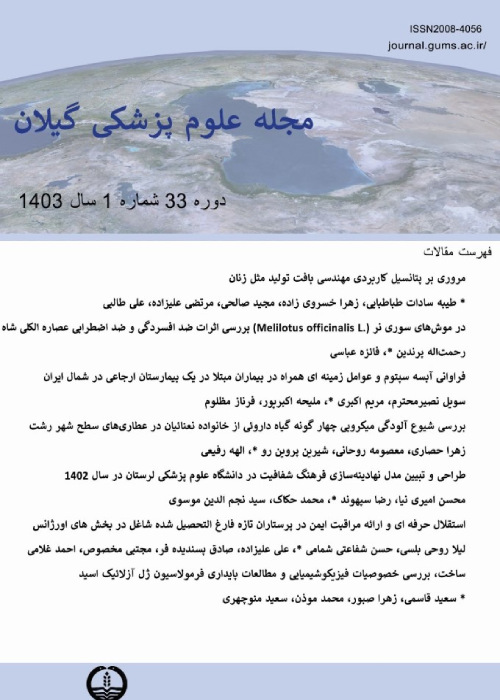Investigating the Seasonal Pattern of Stroke Incidence and the Association Between Daily Stroke Occurrences and Meteorological Factors
Author(s):
Abstract:
Abstract
Introduction
Cerebrovascular disease is the second leading cause of death worldwide. Data on epidemiology of stroke, its pattern and risk factors, are scarce. Seasonal variation in the incidence of stroke and role of meteorological factors in its occurrence, have been investigated in several studies. These studies show that there were different patterns in stroke incidence across different areas. Objective
To investigate the seasonal pattern of stroke incidence and the association between daily stroke occurrences and meteorological factors among the patients admitted to the Poursina Hospital, northern Iran, in (2012). Materials And Methods
This cross sectional study was conducted in the Poursina Hospital in Rasht. All the patients with acute onset of neurological symptoms during (2012), after performing imaging studies and confirmation of the diagnosis of stroke, were enrolled. Age, sex, history of diabetes and hypertension, and date of stroke occurrence were recorded for all patients. The number of stroke episodes, temperature and humidity were recorded on all days of the year. Distribution of stroke cases among seasons according to study variables, was analyzed using chi-square test. To compare the average number of strokes per day among different seasons, kruskal-wallis test was used. The relationship between the number of strokes per day and meteorological variables was analyzed using Spearman's correlation coefficient. Results
During the study period, 869 patients with diagnosis of stroke were admitted. Significant seasonal differences in the mean of ischemic stroke occurrence per day and mean of intracerebral hemorrhage occurrence per day, with peak rates in autumn, were observed. In the study of meteorological variables based on multiple linear regression with step-wise method, minimum temperature was inverse linear predictor of both overall stroke occurrence per day and ischemic stroke occurrence per day. For intracerebral hemorrhage occurrence per day, maximum temperature was inverse linear predictor and maximum humidity was direct linear predictor. Conclusion
This study suggests a seasonal pattern in the incidence of stroke and a possible role of meteorological factors in the incidence of stroke in this area. Attention to this seasonal pattern can be useful for medical centers to provide better services to their patientsKeywords:
Language:
Persian
Published:
Journal Of Guilan University Of Medical Sciences, Volume:23 Issue: 90, 2014
Pages:
50 to 58
magiran.com/p1284496
دانلود و مطالعه متن این مقاله با یکی از روشهای زیر امکان پذیر است:
اشتراک شخصی
با عضویت و پرداخت آنلاین حق اشتراک یکساله به مبلغ 1,390,000ريال میتوانید 70 عنوان مطلب دانلود کنید!
اشتراک سازمانی
به کتابخانه دانشگاه یا محل کار خود پیشنهاد کنید تا اشتراک سازمانی این پایگاه را برای دسترسی نامحدود همه کاربران به متن مطالب تهیه نمایند!
توجه!
- حق عضویت دریافتی صرف حمایت از نشریات عضو و نگهداری، تکمیل و توسعه مگیران میشود.
- پرداخت حق اشتراک و دانلود مقالات اجازه بازنشر آن در سایر رسانههای چاپی و دیجیتال را به کاربر نمیدهد.
In order to view content subscription is required
Personal subscription
Subscribe magiran.com for 70 € euros via PayPal and download 70 articles during a year.
Organization subscription
Please contact us to subscribe your university or library for unlimited access!


